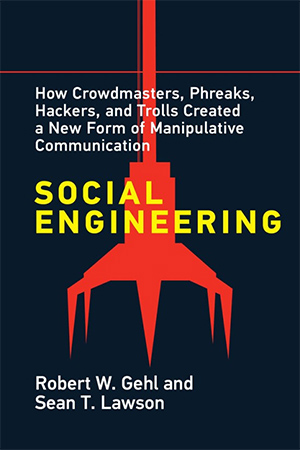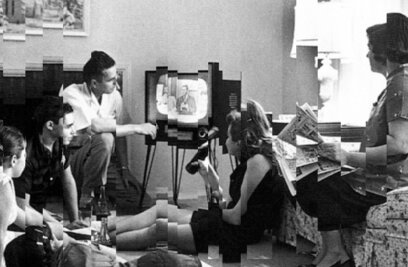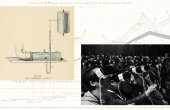Masters of Crowds: The Rise of Mass Social Engineering

In a house in Cambridge, Massachusetts, in 1990, a 40-something Marxian critical scholar of consumerism interviewed a wizened man of nearly 100 years, a man who had helped build the very consumer society the scholar was criticizing. The younger man was Stuart Ewen, a professor of film and media studies at Hunter College. The older was Edward Bernays, one of the most important public relations pioneers of the 20th century.

Although their backgrounds were different, Bernays warmed up to Ewen, seeing him as a member of an “intelligent few” who was “charged with the responsibility of contemplating and influencing the tide of history.” Ewen was, after all, a published author and a professor. Bernays saw himself as an intellectual, a theorist of public relations — the field he had helped create in the 1920s.
In his interview with Ewen, Bernays explained his theory of the role of public relations in society. Since Ewen was a member of the “intelligent few,” Bernays felt that he could be frank about the field’s elitism. In his book “PR!: A Social History of Spin,” Ewen writes:
As a member of that intellectual elite who guides the destiny of society, the [public relations] “professional,” Bernays explained, aims his craft at a general public that is essentially, and unreflectively, reactive. Working behind the scenes, out of public view, the public relations expert is an “applied social scientist,” educated to employ an understanding of “sociology, psychology, social psychology, and economics” to influence and direct public attitudes. Throughout our conversation, Bernays conveyed his hallucination of democracy: A highly educated class of opinion-molding tacticians is continuously at work, analyzing the social terrain and adjusting the mental scenery from which the public mind, with its limited intellect, derives its opinions.
Ewen, who had studied the writing of Bernays for years and had authored books on “captains of consciousness” and consent engineering, was probably not surprised to hear this hierarchical vision of society, where “people in power . . . shape the attitudes of the general population.”
Right up to the end of his life, Bernays held fast to his belief that leadership would come from an elite, technocratic few who would shape the masses’ reality and thus produce a better society.
Today, Bernays’s elitism sounds out of date, even dangerously anti-democratic. This is especially so when we are told that our opinions matter, that social movements can use contemporary media to spread their messages, and that we can finally speak truth to power. Even in the 1990s, when Ewen interviewed Bernays, the old man’s ideas seemed offensive.
Indeed, Bernays was a product of another time, the early 20th century, a time when elite experts — especially engineers — were seen as humanity’s saviors. Right up to the end of his life (Bernays died in 1995, a few years after Ewen’s visit), he held fast to his belief that the masses needed leadership, and that leadership would come from an elite, technocratic few who would shape the masses’ reality and thus produce a better society.
These elites used a variety of names for themselves: “public relations professional,” “news engineers,” “engineers of consent,” “crowd-men.” We will call them mass social engineers. Their roots lie in the turn of the 20th century, a period when engineering was held in high esteem, so much so that people believed society itself could be engineered just as easily as a bridge or canal could be.
Engineering Society
Writing in 1976, civil engineer and author Samuel C. Florman pined for the “Golden Age of Engineering” — a period he defined as 1850 to 1950. During this Golden Age, especially in the early 1900s, engineers aspired to be “benefactors to mankind.” Flush with pride over massive successes — canals, bridges, dams, and public infrastructures — engineers came to believe that their profession would lead to democratically distributed prosperity for all of mankind. “Since the lot of the common man had traditionally been one of unrelenting hardship,” Florman writes, “engineers during the golden age looked upon their works as man’s ‘redeemer from despairing drudgery and labor.’” Once the common man was released from drudgery, the engineers reasoned, he would inevitably become educated, cultured and enobled, and this improvement in the race would also be to the credit of the engineering profession. Improved human beings, of course, would be happier human beings.
Hence, turn-of-the-century engineers aspired to take their skills in practical application of scientific knowledge and improve the lot of humanity. Arguably, they did — for example, new sanitation systems contributed greatly to the health of urban environments.
Given the seemingly boundless power of engineering and the flexibility of its central approach of applying scientific knowledge to practical problems, perhaps it is no surprise that the label “engineer” began to be used beyond the civil domain. At the beginning of the 20th century, we see specializations of the field: electrical engineering, municipal engineering, sanitary engineering, and industrial engineering, to name a few.
All engineering is social, of course, affecting how societies function. Some subfields of engineering are more directly targeted at human action than others. Sanitary engineering, for example, affected habits of waste and consumption in urban centers. Through a seemingly politically neutral process of building infrastructures such as sewage systems, engineers started to see how their work could directly shape society.
Through a seemingly politically neutral process of building infrastructures such as sewage systems, engineers started to see how their work could directly shape society.
The most direct expression of this engineering-of-society mindset that appeared in the early 1900s could not be clearer: the title of “social engineer.” In the late 19th and early 20th centuries, a new wave of experts emerged. They sought facts, spread middle-class white American values, and worked to make everything more efficient. They placed expertise and elite knowledge above mass democratic decision-making. Their use of the title “social engineer” helped them gain legitimacy by appropriating the successes of civil and mechanical engineering. They argued that scientific thinking could be applied to society.
Social engineers of this period came in three varieties. There were social reformers — Social Gospel Christian activists and early sociologists — who sought to reform society. There were management theorists, who were studying ways to manage workers in industrial capitalism. And later, there were public relations specialists, who mixed the language of social reform with the elitism of management and took to new mass media to shape society as a whole. This is the group we call mass social engineers.
Social Reformers
As multiple historians have noted, late 19th- and early 20th-century America was marked by anxieties: New immigrants from Eastern Europe were thought to be diluting American values. Striking workers and socialists clashed with laissez-faire capitalists, causing social unrest with competing visions of political economy. And growth in production was leading to inefficiencies in the market because of a lack of consumers. Perhaps the best expression of these anxieties came in the symbol of the crowd — the irrational masses of humanity who could not govern themselves due to their overwhelming passions, hysteria, and lack of conformity. Turn-of-the-century thinkers such as Gustave Le Bon, Walter Lippmann, and Gerald Stanley Lee warned of the dangers of these crowds. As Le Bon famously argued, “the divine right of the masses is about to replace the divine right of kings.” The crowd was supplanting traditional leaders, bringing about fears of mob rule.
As an antidote to the unruly crowd, social theorists began to explore ways to engineer a better society. This positivist vision was fueled in part by the advent of new social sciences at the turn of the 20th century, particularly sociology, economics, and psychology, which promised to illuminate the previously messy world of human action. The basic idea was to implement the expert knowledge gleaned from sociological surveys, economic analysis, or psychological theorizing into specific social programs meant to guide the newly ascendant masses. As the president of the American Statistical Association put it in 1937, the application of social science to social ills would be social engineering, just as the application of physics to bridge-building was called engineering.
As social reformers scaled up their efforts, they found that their social expertise alone wasn’t enough; they needed to partner with powerful interests to implement their visions of benevolent social control.
An early example of this line of thinking is found in the work of Edwin Earp, a professor of Christian sociology at the Drew Theological Seminary. Blending together Methodist theology and social science, Earp’s 1911 book “The Social Engineer” promoted “greater emphasis in education upon applied science, upon those studies in mechanics and engineering that will equip men for doing things as well as knowing things.” Such practical application of social scientific knowledge — mixed with the moral guidance of Christian theology — would alleviate a range of social problems, including class conflict, racial strife, “woman and child labor,” divorce, “gamblers versus the people,” and above all, unemployment. For Earp,
Social engineering means not merely charities and philanthropies that care for the victims of vice and poverty, but also intelligent organized effort to eliminate the causes that make these philanthropies necessary, and it means also an attempt at a readjustment of our economic and industrial system by wise statesmanship through social control, so that the profits of social production may be more equitably distributed to all the legitimate factors in society.“
“Social control” was indeed a watchword of the social reformers, a watchword that would remain central to the mass social engineers we will discuss below.
Social control through social engineering found advocates among middle-class Americans concerned about integrating the waves of predominantly Eastern European immigrants into U.S. society. The Settlement House Movement is a key example. Found in cities such as Chicago, New York, and Boston, settlement houses were located in tenement neighborhoods populated by new immigrants who came to work in factories. In them, affluent young men and women would settle “among the urban poor, share their lot, and help them improve their lives,” writes historian John F. McClymer in his book “War and Welfare: Social Engineering in America.” These social reformers ran English classes, kindergartens, arts, crafts, and music classes, and discussion salons, all with the intention of “Americanizing” the immigrants.
Initially, the settlement house movement was driven by followers of Social Gospel evangelism, but over time, it became secularized and professionalized. The administrators and participants of settlement houses started college programs and began collecting data on the inhabitants of the neighborhoods they were located in, seeking out social causes for poverty and failures to assimilate into mainstream U.S. society, and offering solutions to this problem. This data collection was eventually scaled up from neighborhoods to the metropolitan level in the form of the famous Pittsburgh Survey or the 1919 report Social Engineering in Cincinnati. As McClymer argues, “social engineers gloried in ‘facts.’ Their first recommendation, no matter what the issue, was invariably the collection of information.” Such sociological data gathering, analysis, and intervention became a “gateway to careers in social engineering.” Data gathering provided a wealth of professional opportunities for social reformers and a platform for social engineering intervention in municipal politics.
During World War I, these social reformers began to target society as a whole for social engineering via government bureaucracies, arguing that their expertise would be invaluable to the war effort. However, as social reformers scaled up their efforts to metropolitan or even national scale, they found that their social expertise alone wasn’t enough; they needed to partner with powerful interests to implement their visions of benevolent social control. They found such a partner among another set of engineer-minded people: scientific managers, who also adopted the term social engineering.
Managerialist Social Engineers
The social reformers were not the only ones using the term social engineering. So, too, were the Scientific Managers, adherents of the philosophy of Frederick Winslow Taylor, a trained engineer famous for his studies of how industrial workers did their jobs. Scientific management targeted the world of industrial work, seeking to make production more efficient.
Turn-of-the-century scientific managers believed, writes historian John Jordan, that “the same laws governing the physical world governed society, so discovery of these laws would lead to the possibility of rational social control, full employment, and economic stability.” This is precisely the same engineering mindset found among the social reformers. Indeed, the fact that many of these managers were actually university-trained engineers only increased their credibility. And the object of social control was eerily similar: The social reformers sought to address the anxiety of assimilating new immigrants, and the managerialists addressed the anxiety brought by labor unrest — that is, unruly crowds of workers brought together in the factories.
Scientific management was, of course, the brainchild of Frederick Taylor, who sought to manage industrial workers by forcing them to operate machinery and move through space in predetermined, efficient ways — the so-called “one best way” to get work done. But Taylor was not alone. His colleague Morris Cooke, explains Jordan, “expanded the domain of engineering from the study and control of materials and physical forces to the study and control of human beings. ‘Social engineering’ is a literal translation of [Cooke’s] definition of scientific management.” Scientific managers like Cooke see the application of an engineering approach as “simply another indication of the passing of what may be called the ‘craft spirit’ in human affairs,” where workers had control over the conception and execution of their jobs, in favor of “the rise of the scientific spirit,” where the manager-engineers would take control over work and the worker is akin to a cog in a machine. Taylor, Cooke, and their colleagues argued that such management would lead to happier and more prosperous workers, eliminating labor unrest.
Managerialism even found its way into the home. Frank Gilbreth’s partner Lillian (another engineer — indeed, one of the first women to get an engineering PhD) made scientific management a way of life in the home. As historian and journalist Jill Lepore writes in an article on the subject, in the 1920s, Lillian Gilbreth
engineered model kitchens — one was called the Kitchen Efficient — and purported to eliminate, for instance, five out of every six steps in the making of coffee cake. To make a lemon-meringue pie, a housewife working in an ordinary kitchen walked two hundred and twenty-four feet; in the Kitchen Efficient, Gilbreth claimed, it could be done in ninety-two.
Scientific Management’s entry into the home was accompanied by its entry into the communities around factories, meeting up with the social reformers who sought to Americanize the immigrant communities flocking to factory towns.
Thus, the social reformer and managerialist strains of social engineering intersected in several ways. They both valued efficiency — social welfare types wanted it for governance, the managers in industry. Both were deeply affected by World War I, subsuming their specific ambitions to the war effort, seeing the war effort as a means to establish the importance of expertise in managing society. For the social welfare school, the war was a chance to help, as historian Nancy Bristow puts it, “make men moral.” For the managerialists, it was an opportunity to further implement their schemes during wartime industrial production and thus keep unruly crowds of laborers under control. And both sought to manage the seemingly unruly crowds of new immigrants who were coming to America around the turn of the 20th century.
However, despite their societal-scale ambitions, both the social reformers and managerialists’ scope were limited to their specific domains. The social reformers operated through bureaucracies, often butting heads against politicians and old-money aristocrats. The managerialists were more successful — after all, they were working with powerful industrialists — but their scope was limited to the workplace, and they too butted heads with government regulators who were leery of big industry. The fullest expression of societal-scale, mass social engineering as a program of social control would take its final shape among a new profession that emerged in the 1920s, drew on the ideas of the social reformers, served the same industrial capitalists the managerialists served, and took as its vehicle the new communication technologies of the day. That profession was public relations, a field dedicated to the “engineering of consent.” These were the mass social engineers.
Public Relations and the Mass Social Engineers
Mass social engineers owe their livelihoods to the electrical engineers who brought about new, electronic mass media in the late 1800s and early 1900s. Telegraphy, radio, cinema, and later television, along with the older technology of newspapers, all created conditions of possibility for coordinated, nation-wide media campaigns.
Very quickly, the ambitions of previous social reformers and managerialists to shape society as a whole seemed possible: Mass media could reach more people than just those in settlement houses or on machine shop floors. Social control on a national level appeared within reach.
The first inklings of this newfound power came from the press agents and publicists of the turn of the 20th century. Social reform-minded journalists, dubbed “muckrakers,” “utilized the power of [the] new mass media to cause a political revolt against the continued abuse of the public interest by ruthless businessmen,” writes Scott Cutlip, a historian and a pioneer in the field of public relations. The businesses under attack, especially railroad corporations, fought back by hiring publicists who would provide industry-friendly news stories to newspapers and magazines and shift the tide of opinion in their favor. However, these efforts were often clumsy, leading to further backlash against railroad corporations.
The clumsiness of the early publicists quickly gave way to a more disciplined — indeed, engineering-like — approach in the form of a new field of public relations, led by Ivy Lee, Doris Fleischman, and Edward Bernays. Their new field of public relations borrowed the language of the social reformers and managerialists.
One of the borrowed terms was “social engineering.” For example, in a chapter in “The Engineering of Consent,” Bernays describes public relations as “a broad social-engineering process.” Like the social reformers and managerialists, the mass social engineers recognized the rhetorical power of claiming to do “engineering.”
They also shared the anxieties the social reformers and managerialists had about social upheaval and crowds. As public relations pioneer Ivy Lee argued in 1915, “this is a period of great unrest. Many strange economic and political theories are being preached.” Such times call for elite experts. “The crowd craves leadership,” Lee argued. The experts must lead, he argued, because demagogues would do so if they did not: if the crowd “does not get intelligent leadership, it is going to take fallacious leadership.” If that is so, Lee reasoned, then public relations professionals, working on behalf of the nation’s social, industrial, and political elites, ought to become the masters of crowds.
Lee’s thinking was heavily influenced by crowd theorists like Gustave Le Bon. And he wasn’t the only Lee concerned about crowds. His second cousin, clergyman Gerald Stanley Lee, argued in his 1913 book “Crowds: A Moving-Picture of Democracy” that the job of the public relations professional is “news engineering.” For Gerald Lee, the news engineer could control unruly crowds and rise to power: “The Secretaries of What People Think, and the President of What People Think—the engineers of the news in this nation—will be the men [sic] who govern it.” The news engineer would be a “crowd-man” capable of leading the masses. Gerald Lee’s arguments appear as a more forceful version of the Christian sociologist Edwin Earp and mix in the elitism of Taylor and the Scientific Managers. His innovation was to turn to the newspaper — the mass medium capable of shaping society if only a conscious news engineer would lead the way.
Gerald Lee’s theory of the news engineer was put into practice by his cousin Ivy Lee. Like the social reformers and managerialists, Ivy Lee and his fellow public relations pioneers took on the task of elite leadership, teaching crowds American values through social control. In addition, public relations adopted the social reformers and managerialists’ love of facts. As Lee argued,
We should see to it that in all matters the public learns the truth but we should take special pains to emphasize those facts which show that we are doing our job as best we can, and which will create the idea that we should be believed in. We should get so many good facts, so many illuminating facts, before the public that they will not magnify the bad. There will always be some bad facts in every business, as long as human nature is frail.
This love of facts translated to an engineering approach to public relations, what Fleischman and Bernays called the “engineering of consent.” A husband and wife team who began a successful public relations firm together in the 1920s, Bernays and Fleischman argued that consent engineering could take place via communication technologies, particularly newspapers and radio. Their use would be guided by the facts gathered from the emerging social and psychological sciences to understand and target “the group mind.” With “the aid of technicians . . . of communication” deploying the cutting edge, social scientific data collection and analysis techniques of the day — e.g., polls, surveys, interviews, and statistics — they believed that political leaders would be able to achieve the engineering of consent for their programs and to do so “scientifically.” Knowledge of the group mind would allow consent engineers to move beyond the techniques of “the old-fashioned propagandist,” who was not versed in science, to control crowds through systematic engineering.
Like Lee, Bernays cautioned that we must recognize that the emerging tools and techniques of mass communication could be used for good or evil, to promote or to subvert democracy, and that, as a result, “mastering the techniques of communication” for promoting socially constructive ends would be necessary for the maintenance of democratic societies. If done right, the consent engineers can become an “invisible government . . . the true ruling power of our country.”
Lee’s news engineering and Bernays and Fleischman’s engineering of consent are the fullest expressions of what we call mass social engineering: the implementation of social science knowledge for the purposes of controlling the crowd. Such a mass social engineering approach echoed the Christian social reformer Earp’s earlier call for “doing things as well as knowing things,” defining the practice of mass social engineering as “action based only on thorough knowledge of the situation and on the application of scientific principles and tried practices to the task of getting people to support ideas and programs.”
Mass social engineering is every bit as practical as bridge building: “Just as the civil engineer must analyze every element of the situation before he builds a bridge,” Bernays wrote, “so the engineer of consent, in order to achieve a worth-while social objective, must operate from a foundation of soundly planned action.” And like any engineer, the mass social engineer has to apply science. Fleischman clarified the engineering approach, arguing for a methodology that public relations professionals continue to use to this day: research, plan, communicate, evaluate. In a 1935 speech, Fleischman called for the women’s fashion industry to adopt this method for a more efficient propaganda program that could communicate the latest fashions with “engineering exactness.” “With this as a basis,” she informs her audience,
you will set the keynote for the public, you will eliminate waste . . . and enable yourself really to avail yourself of the tools and techniques of propaganda without loss, with fullest efficiency and ultimately with the wholehearted approval of the public and the individual industries.
Thus, much like the social reformers who gathered data on their target neighborhoods, or the managerialists with their efficiency-minded work motion studies, Lee, Bernays, and Fleischman prescribed a method for mass social engineers: get the facts, study the public, discern psychological ways to influence them, and communicate with them, ideally by creating newsworthy events.
But more so than social reformers or managerialists, their approach was expansive. Mass social engineering had wide applications across every domain of American life, from consumption (e.g., Fleischman’s recommendations to the fashion industry) to support for industry (e.g., Lee’s work for the railroads) to support for war efforts (e.g., Bernays’s work as part of the World War I Creel Committee). This was crowd mastery on a large scale. Overall, if the mass social engineer is successful, Bernays famously argued “the ideas conveyed by the words will become part and parcel of the people themselves.”
Robert W. Gehl is F. Jay Taylor Endowed Research Chair of Communication at Louisiana Tech University, author of “Weaving the Dark Web,” and co-author (with Sean Lawson) of “Social Engineering,” from which this article is adapted.
Sean T. Lawson is Associate Professor of Communication at the University of Utah, Non-Resident Fellow at the Brute Krulak Center for Innovation & Future Warfare at the Marine Corps University, and author of “Cybersecurity Discourse in the United States.“
An Open Access edition of “Social Engineering” can be freely accessed here.
Bibliography:
Abu Arqoub, Omar Ahmad, Bahire Efe Özad, and Adeola Abdulateef Elega. “The Engineering of Consent: A State-of-the-Art Review.” Public Relations Review 45, no. 5 (December 1, 2019). https://doi.org/10.1016/j.pubrev.2019.101830.
Bernays, Edward L. Crystallizing Public Opinion. 1923.
Bernays, Edward L. The Engineering of Consent. Philadelphia, 1947.
Bernays, Edward L. Propaganda. New York: H. Liveright, 1928.
Braverman, Harry. Labor and Monopoly Capital; the Degradation of Work in the Twentieth Century. New York: Monthly Review Press, 1974.
Bristow, Nancy K. Making Men Moral: Social Engineering during the Great War. New York: New York University Press, 1996.
Buckley Jr., William F. “Our Mission Statement.” National Review, November 19, 1955. https://www.nationalreview.com/1955/11/our-mission-statement-william-f-buckley-jr/.
Cutlip, Scott M. The Unseen Power: Public Relations, A History. Hillsdale, NJ: Lawrence Erlbaum, 1994.
Davis, Joseph S. “Statistics and Social Engineering.” Journal of the American Statistical Association 32, no. 197 (1937): 1–7.
Dennison, Henry S. Organization engineering. New York: McGraw-Hill, 1931.
Earp, Edwin Lee. The Social Engineer. New York, Eaton & Mains; Cincinnati, Jennings & Graham, 1911. http://archive.org/details/cu31924014043370.
Ewen, Stuart. Captains of Consciousness: Advertising and the Social Roots of the Consumer Culture. New York: McGraw-Hill, 1976.
Ewen, Stuart. PR! A Social History of Spin. New York: Basic Books, 1996.
Fleischman, Doris E. An Outline of Careers for Women; a Practical Guide to Achievement. Garden City, NY: Doubleday, Doran, 1928. https://catalog.hathitrust.org/Record/001106416.
Florman, Samuel C. The Existential Pleasures of Engineering. New York: St. Martin’s, 1996.
Jordan, John M. Machine-Age Ideology: Social Engineering and American Liberalism, 1911–1939. New ed. Chapel Hill, NC: The University of North Carolina Press, 2010.
Kellogg, Paul Underwood. The Pittsburgh Survey: Findings in Six Volumes. New York: Charities Publication Committee, 1910.
Krenn, Mario. “From Scientific Management to Homemaking: Lillian M. Gilbreth’s Contributions to the Development of Management Thought.” Management & Organizational History 6, no. 2 (May 1, 2011). https://doi.org/10.1177/1744935910397035.
Lamme, Margot Opdycke. “Outside the Prickly Nest: Revisiting Doris Fleischman.” American Journalism 24, no. 3 (July 1, 2007): 85–107. https://doi.org/10.1080/08821127.2007.10678080.
Le Bon, Gustave. The Crowd: A Study of the Popular Mind. London: Ernest Benn, 1896.
Lee, Gerald Stanley. Crowds: A Moving-Picture of Democracy. Garden City, NY: Doubleday Page, 1913. http://www.gutenberg.org/ebooks/15759.
Lepore, Jill. “Not So Fast.” New Yorker, October 5, 2009. https://www.newyorker.com/magazine/2009/10/12/not-so-fast.
Marine, Gene. America the Raped: The Engineering Mentality and the Devastation of a Continent. New York: Simon & Schuster, 1969.
McClymer, John F. War and Welfare: Social Engineering in America, 1890–1925. Westport, CT.: Greenwood Press, 1980.
Mills, C. Wright. The Sociological Imagination. New York: Oxford University Press, 1959.
Phillips, Kevin. Mediacracy: American Parties and Politics in the Communications Age. Garden City, NY: Doubleday, 1975.
Schultz, Stanley K., and Clay McShane. “To Engineer the Metropolis: Sewers, Sanitation, and City Planning in Late-Nineteenth-Century America.” The Journal of American History 65, no. 2 (1978): 389–411. https://doi.org/10.2307/1894086.
Taranto, James. “The Right’s Happy Warrior.” Wall Street Journal, April 30, 2010.




